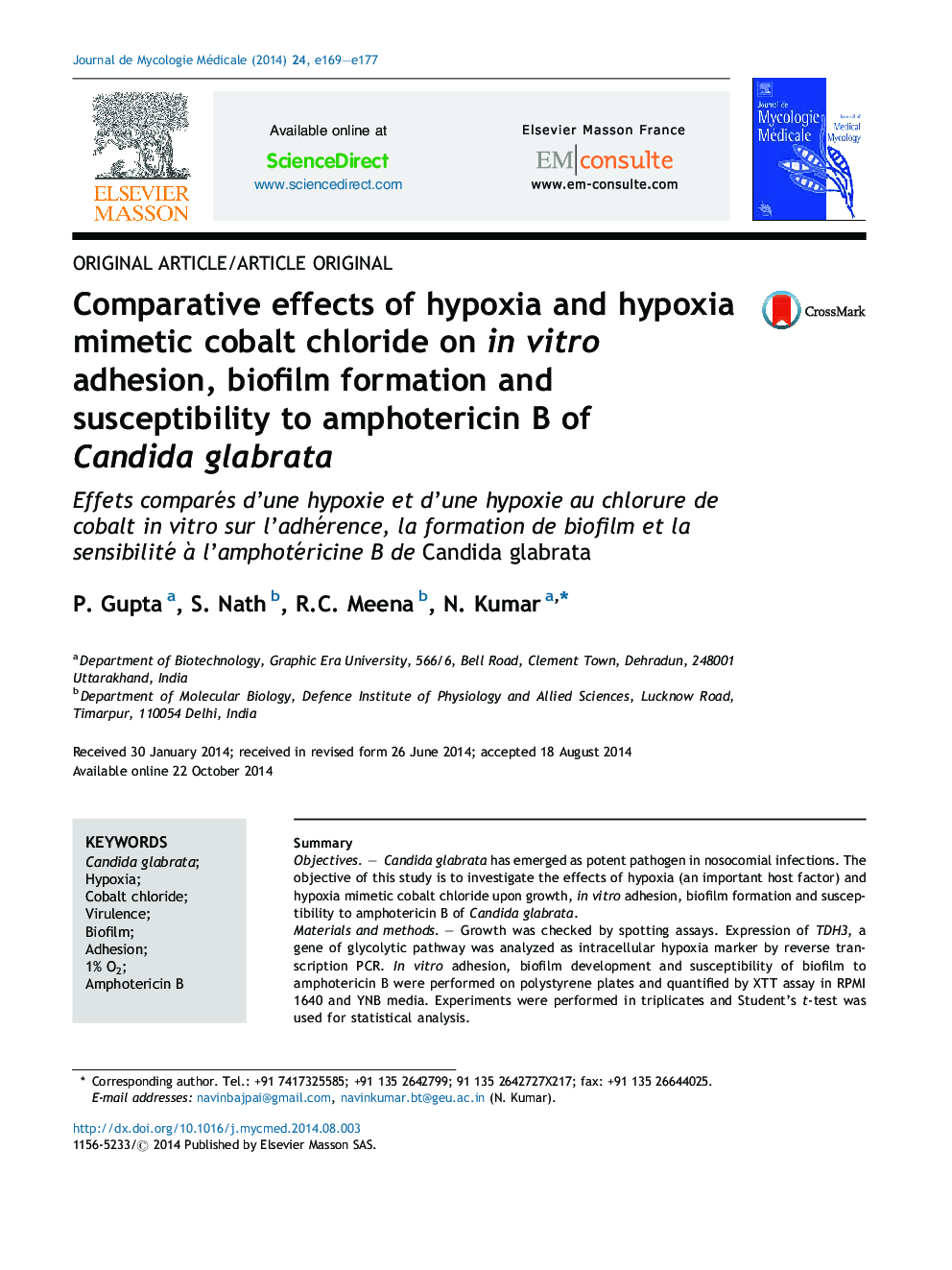| کد مقاله | کد نشریه | سال انتشار | مقاله انگلیسی | نسخه تمام متن |
|---|---|---|---|---|
| 3219871 | 1204456 | 2014 | 9 صفحه PDF | دانلود رایگان |

SummaryObjectivesCandida glabrata has emerged as potent pathogen in nosocomial infections. The objective of this study is to investigate the effects of hypoxia (an important host factor) and hypoxia mimetic cobalt chloride upon growth, in vitro adhesion, biofilm formation and susceptibility to amphotericin B of Candida glabrata.Materials and methodsGrowth was checked by spotting assays. Expression of TDH3, a gene of glycolytic pathway was analyzed as intracellular hypoxia marker by reverse transcription PCR. In vitro adhesion, biofilm development and susceptibility of biofilm to amphotericin B were performed on polystyrene plates and quantified by XTT assay in RPMI 1640 and YNB media. Experiments were performed in triplicates and Student's t-test was used for statistical analysis.ResultsHypoxia did not compromise the growth of C. glabrata unlike CoCl2. Hypoxia and CoCl2 upregulated TDH3 expression. Adhesion was reduced upon exposure to hypoxia and CoCl2. Biofilm activity remained unchanged in the presence of CoCl2 in both media. In comparison to normoxia control, hypoxia increased biofilm activity to 259.33 ± 22.05% in RPMI 1640, while hypoxia reduced it to 70.99 ± 2.99% in YNB. Biofilm susceptibility to amphotericin B was significantly decreased in RPMI 1640 and remained unaffected in YNB in hypoxia.ConclusionsC. glabrata grows well even under hypoxia but not upon CoCl2 exposures. CoCl2 mimics hypoxia like expression of TDH3 but affects the virulence properties unlike hypoxia. Both, hypoxia and CoCl2 affects adhesion adversely. Hypoxia increases biofilm development and reduces the susceptibility of biofilm to amp B in RPMI 1640 but not in YNB.
RésuméObjectifsCandida glabrata a émergé comme un important agent pathogène, cause d’infections nosocomiales. L’objectif de cette étude était d’étudier les effets d’une hypoxie (un important facteur de l’hôte) et l’hypoxie induite par le chlorure de cobalt sur la croissance in vitro, sur l’adhérence, la formation de biofilm et la sensibilité à l’amphotéricine B de C. glabrata.Matériels et méthodesLa croissance a été étudiée par un spotting test. L’expression de TDH3, un gène de la voie glycolytique, a été analysée comme marqueur d’une hypoxie intracellulaire par transcription inverse-PCR. In vitro, l’adhérence, le développement de biofilm et la sensibilité des biofilms à l’amphotéricine B ont été étudiés sur plaques de polystyrène et quantifiés par dosage XTT en milieu RPMI 1640 et YNB. Des expériences ont été effectuées en triplicate et le test t de Student a été utilisé pour l’analyse statistique.RésultatsHypoxie n’a pas compromis la croissance de C. glabrata contrairement à l’action du CoCl2. Hypoxie et CoCl2 exercent une régulation positive sur l’expression de TDH3. L’adhérence était réduite lors de l’exposition à l’hypoxie et au CoCl2. La production de biofilm est restée inchangée en présence de CoCl2 dans les deux milieux. En comparaison de contrôles en normoxie, l’hypoxie a augmenté la production de biofilm de 259,33 ± 22,05 % en RPMI 1640, tandis qu’une hypoxie a réduit cette production de 70,99 ± 2,99 % en YNB. La sensibilité du biofilm à l’amphotéricine B a été considérablement diminuée en RPMI 1640 et est restée inchangée en YNB en hypoxie.ConclusionsC. glabrata pousse bien, même sous hypoxie mais pas en présence de CoCl2. Le CoCl2 imite une hypoxie pour l’expression de TDH3 mais affecte des propriétés de virulence contrairement à l’hypoxie. Hypoxie et CoCl2 affectent négativement l’adhérence. L’hypoxie augmente le développement de biofilm et réduit la sensibilité du biofilm à l’amphotéricine B en RPMI 1640 mais pas en YNB.
Journal: Journal de Mycologie Médicale / Journal of Medical Mycology - Volume 24, Issue 4, December 2014, Pages e169–e177